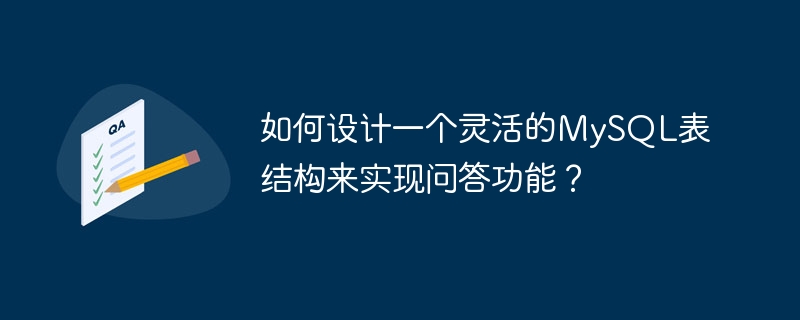

How to design a flexible MySQL table structure to implement the question and answer function?
Overview:
The question and answer function is a common requirement in many application scenarios, including forums, knowledge bases, communities and other applications. When designing the question and answer function, a reasonable database table structure can improve query efficiency and scalability. This article will introduce how to design a flexible MySQL table structure to implement the question and answer function, and provide specific code examples.
CREATE TABLE users (
id INT PRIMARY KEY AUTO_INCREMENT,
username VARCHAR(255) NOT NULL,
password VARCHAR(255) NOT NULL,
email VARCHAR(255) NOT NULL,
created_at TIMESTAMP DEFAULT CURRENT_TIMESTAMP
);CREATE TABLE questions (
id INT PRIMARY KEY AUTO_INCREMENT,
user_id INT NOT NULL,
title VARCHAR(255) NOT NULL,
content TEXT NOT NULL,
created_at TIMESTAMP DEFAULT CURRENT_TIMESTAMP,
FOREIGN KEY (user_id) REFERENCES users(id)
);CREATE TABLE answers (
id INT PRIMARY KEY AUTO_INCREMENT,
question_id INT NOT NULL,
user_id INT NOT NULL,
content TEXT NOT NULL,
created_at TIMESTAMP DEFAULT CURRENT_TIMESTAMP,
FOREIGN KEY (question_id) REFERENCES questions(id),
FOREIGN KEY (user_id) REFERENCES users(id)
);In the above table structure, the question table and answer table are associated with the user table through foreign keys respectively, realizing the relationship between questions and answers and users. At the same time, proper use of indexes can improve query efficiency.
CREATE TABLE tags (
id INT PRIMARY KEY AUTO_INCREMENT,
name VARCHAR(255) NOT NULL
);In order to realize the many-to-many relationship between questions and tags, you can design an association table (question_tags) to store the association between questions and tags. You can design the following fields:
CREATE TABLE question_tags (
question_id INT NOT NULL,
tag_id INT NOT NULL,
PRIMARY KEY (question_id, tag_id),
FOREIGN KEY (question_id) REFERENCES questions(id),
FOREIGN KEY (tag_id) REFERENCES tags(id)
);By using an association table to store the association between questions and labels, you can achieve a many-to-many relationship in which one question can have multiple labels, and one label can be associated with multiple questions.
INSERT INTO questions (user_id, title, content) VALUES (1, '如何设计一个灵活的MySQL表结构', '请问How to design a flexible MySQL table structure to implement the question and answer function?');
INSERT INTO answers (question_id, user_id, content) VALUES (1, 2, '你可以设计一个问题表、回答表和标签表来实现问答功能。');
INSERT INTO tags (name)
VALUES ('数据库'), ('问答');INSERT INTO question_tags (question_id, tag_id) VALUES (1, 1), (1, 2);
SELECT q.title, q.content, u.username, a.content FROM questions q JOIN users u ON q.user_id = u.id JOIN answers a ON q.id = a.question_id WHERE q.id = 1;
By using the above code examples, you can create questions, answer questions, add tags, and query questions and related answers.
Summary:
Designing a flexible MySQL table structure to implement the question and answer function can improve query efficiency and scalability. According to needs, you can design user tables, question tables, answer tables, tag tables and other tables, and realize the association between different tables through foreign keys and association tables. At the same time, proper use of indexes can improve query efficiency. By using the above table structure and sample code, the question and answer function can be implemented and has the ability to be expanded.
The above is the detailed content of How to design a flexible MySQL table structure to implement the question and answer function?. For more information, please follow other related articles on the PHP Chinese website!
 What are the network file server tools?
What are the network file server tools?
 Implementation method of vue online chat function
Implementation method of vue online chat function
 How to restore videos that have been officially removed from Douyin
How to restore videos that have been officially removed from Douyin
 Why the computer keeps restarting automatically
Why the computer keeps restarting automatically
 How to recover files emptied from Recycle Bin
How to recover files emptied from Recycle Bin
 How to solve http status 404
How to solve http status 404
 Regular expression does not contain
Regular expression does not contain
 What are the sorting methods?
What are the sorting methods?




